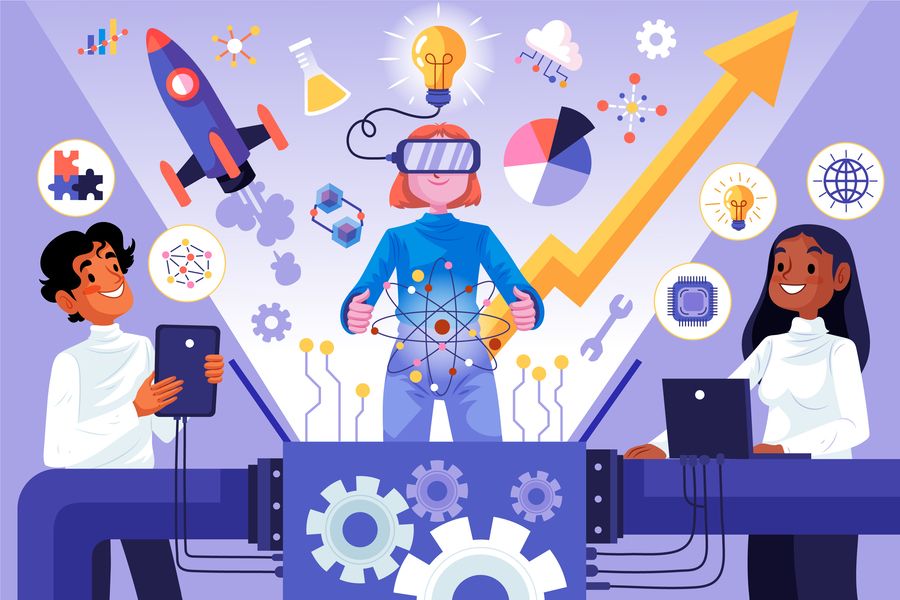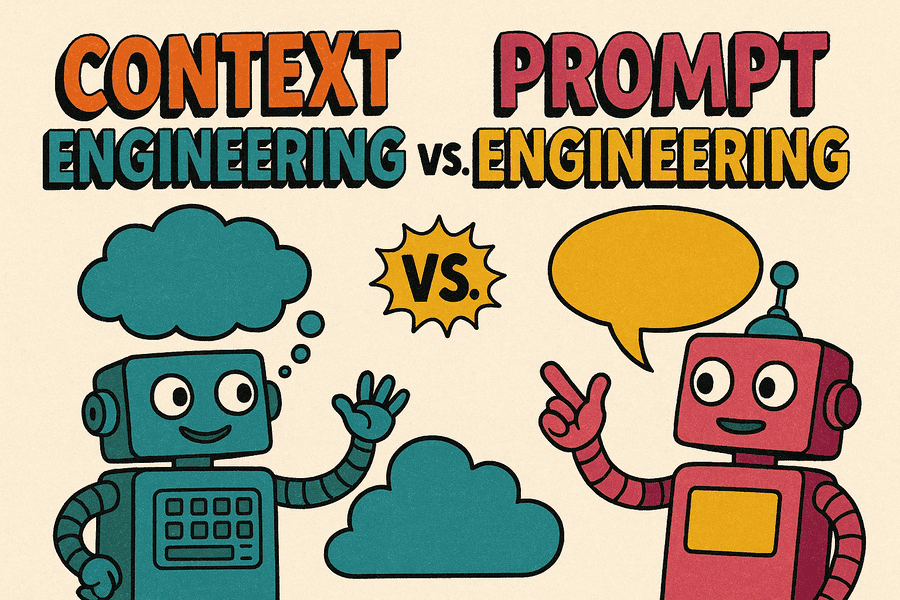
Context Engineering: The New Frontier in AI System Design
What Is Context Engineering?
Context engineering is the practice of structuring and providing the right data, background knowledge, and signals to large language models (LLMs) so they generate accurate, useful outputs. Unlike prompt engineering (which focuses on crafting inputs), context engineering manages the entire context window—the information environment an AI system relies on to reason and respond.
How Is Context Engineering Different From Prompt Engineering?
Prompt engineering asks: “What question should I ask and how should I phrase it?” Context engineering asks: “What supporting data, references, and background should I provide so the AI delivers the best result?” It focuses on designing the full information ecosystem, not just the prompt.
Why Is the Context Window Important?
The context window is the limited segment of data an AI model can process at once (measured in tokens). Even with large windows (e.g., 128k+ tokens), engineers must select and structure content so the model focuses on the most relevant, timely information. Context engineering is the art of filling that window strategically to maximize accuracy, relevance, and performance.
Why Context Engineering Matters for AI and LLMs

What Problems Does Context Engineering Solve?
Prompt engineering alone struggles with complex, real-world scenarios (legal analysis, enterprise search, multi-step reasoning). The needed information is often scattered or lengthy. Without the right context, a clever prompt won’t help.
Context engineering addresses:
- Information overload: Prioritizes the most relevant data to avoid wasted tokens.
- Relevance: Grounds outputs in accurate, high-quality sources.
- Consistency: Structures context to remain reliable across multi-turn conversations.
- Scalability: Enables enterprise-grade systems where prompts alone break down.
How Does It Work in Practice?
Example: a legal research assistant. A simple prompt like “Summarize the relevant case law for this dispute.” fails unless the model has access to statutes, rulings, facts, and user preferences. Context engineering:
- Selects the most applicable documents from large knowledge bases.
- Summarizes/compresses them to fit within the window.
- Structures information for efficient synthesis and reference.
The result is a system that’s more accurate, scalable, and trustworthy.
Core Principles of Context Engineering

Relevance & Selectivity
Every token is valuable. Focus on:
- Filtering out irrelevant/repetitive info
- Prioritizing critical content for the task
- Adapting dynamically as the scenario evolves
Structure & Formatting
How info is presented matters:
- Ordering: Put essentials first
- Formatting: Bullets, tables, markers guide attention
- Separation: Distinguish facts, instructions, references
Dynamic Adaptation
- Update facts and preferences as interactions continue
- Integrate real-time data (markets, sensors)
- Manage memory/history efficiently
How to Apply Context Engineering: Best Practices & Techniques
Data Gathering & Curation
- Internal knowledge bases, docs, APIs
- User preferences and history
- External sources (web, news, scientific literature)
Filter noise; prefer authoritative, up-to-date sources.
Contextual Compression & Summarization
- Summarization: Extractive or generative
- Fact extraction: Names, dates, entities
- Chunking: Smaller sections for sequential processing
Recursive summarization (summaries of summaries) can maximize fit.
Tooling & Automation
- RAG: Retrieval-Augmented Generation for real-time snippets
- Vector DBs & semantic search: Conceptual similarity
- Automated builders: LangChain, LlamaIndex
Evaluating & Iterating
- A/B test context structures
- Measure output quality and factual accuracy
- Collect user feedback
Refine selection and structure; balance fine-tuning vs. in-context learning.
Common Pitfalls & Challenges

Overfitting & Irrelevance
- Distraction: Unimportant details dominate
- Contradiction: Conflicting inputs confuse models
- Overfitting: One-off contexts don’t generalize
Mitigation: Ongoing curation and validation.
Computational Constraints
- Latency (fast retrieval/assembly)
- Cost (LLM calls, summarization, DB queries)
- Scalability (many users/sessions)
Mitigation: Caching, pre-processing, efficient retrieval pipelines.
Human–AI Collaboration
- Misread intent → irrelevant context
- Lack of transparency → distrust
- Selection bias → skewed outputs
Mitigation: Close collaboration between domain experts, engineers, and users.
Context Engineering vs. Prompt Engineering: Key Differences

Use Cases & Examples
| Feature | Prompt Engineering | Context Engineering |
|---|---|---|
| Scope | Crafts the input query/instruction | Curates, organizes, and structures supporting information |
| Complexity | Great for simple, self-contained tasks | Essential for multi-step, data-rich, dynamic tasks |
| Example | “Write a poem about the ocean.” | Provide marine research, preferred style, and key facts before asking for the poem |
| Tools | Prompt templates, few-shot examples | RAG, vector DBs, summarization pipelines, automated context builders |
| Limitations | Fails when needed knowledge isn’t in prompt/weights | Can be cost/latency intensive and complex to manage |
When to Use Each
- Prompt engineering: Rapid prototyping, simple queries, well-defined tasks.
- Context engineering: Enterprise AI, research assistants, support bots—any scenario with dynamic or large-scale knowledge.
The Future of Context Engineering

Evolving LLM Capabilities
As context windows grow (e.g., GPT-4 Turbo, Claude), context engineering will enable richer reasoning, personalization at scale, and real-time data integration—while increasing the need for careful curation and structure.
Role in Autonomous Agents
- Memory management for long sessions
- Goal adaptation as objectives shift
- Tool use via APIs/DBs with dynamic updates
Effective context engineering will separate reliable AI agents from hallucination-prone ones.
Getting Started with Context Engineering

Skills, Tools, & Resources
- Skills: info retrieval, text processing, summarization, prompt basics, LLM APIs
- Tools: LangChain, LlamaIndex, Pinecone/FAISS/Weaviate, RAG pipelines, OpenAI/Anthropic/Cohere APIs
Community & Learning Paths
- Phil Schmid
- LangChain docs
- Hugging Face forums
- OpenAI & Anthropic developer guides
- Beyond the Perfect Prompt
How to Practice
- Build small RAG demos
- Join hackathons/open source
- Experiment with summarization & selection
- Share patterns; get feedback
Also see the differences between LLMs and Generative AI to know where context matters most.
Conclusion: Why Context Engineering Is the Next Essential AI Skill
As LLMs advance, the bottleneck shifts from asking to supplying the right information. Robust context engineering unlocks consistent, accurate, context-aware results across enterprise search, assistants, and agents.
Master curating, compressing, and structuring the right information, at the right moment, in the right way—and turn AI from a black box into a true collaborator.
References
- Phil Schmid — Context Engineering: Prompt Engineering on Steroids
- Simon Willison — Context Engineering
- LangChain Blog: The Rise of Context Engineering
- Nate’s Newsletter — Beyond the Perfect Prompt
- AI Intellectronica: Context Engineering Primer





